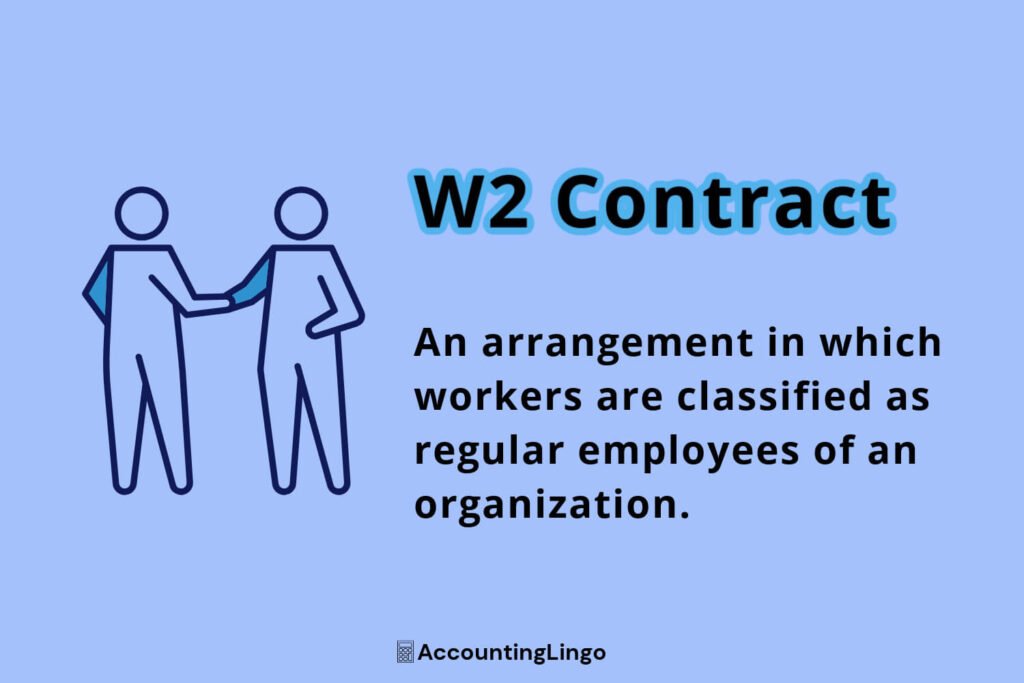
Understanding a W2 Contract
Are you a freelancer or independent contractor looking to switch to a W2 contract? Or maybe you’re an employer considering offering W2 contracts to your workforce? Either way, understanding the benefits and considerations of a W2 contract is crucial before making any decisions.
This article will review what a W2 contract means, how to negotiate one, and explore how they differ from other employment arrangements. We’ll cover everything from the stability and security they offer to the tax implications and legal responsibilities involved.
What is a W2 Contract?
A W2 contract is an arrangement in which workers are classified as regular employees of an organization. Other variations may include “W2 contractor” or “W2 contract job,” which often relates to individuals working as a contractor for an organization via a temporary staffing agency. In this case, the staffing agency commonly issues a form W2 at the end of the year.
What a W2 Contract Means
A W2 contract is a type of employment agreement in which a company hires an individual as a full-time employee. The term “W2” refers to the IRS tax form employers utilize when reporting employee wages, tips, and other income sources. When hired as a W2 employee, your employer withholds taxes on your behalf, and you are entitled to various benefits and protections employment laws provide.
This could be contrasted with being classified as an independent contractor, whereby you must pay your own taxes and do not receive employee benefits. W2 contracts are commonly used in traditional employment settings but can also be found in certain freelance or consulting arrangements.
Many characteristics of a W2 contract distinguish it from other forms of employment arrangements. First, as a W2 employee, you are considered part of the company’s workforce.
This means you will likely have a set schedule, work at the company’s office or as instructed by the employer, and be subject to the organization’s policies and procedures. You may also qualify for various benefits like health insurance, retirement plans, paid time off, and other perks not commonly available to independent contractors.
Another aspect to note is W2 contracts often come with a perceived view of higher job security than freelance or contract work. Employees are protected by federal and state employment laws, which provide safeguards against wrongful termination and discrimination. In addition, it’s crucial to recognize W2 contracts also have certain obligations and considerations for both employees and employers.
Benefits of a W2 Contract for Employees
Employees have several benefits to consider when accepting W2 employment. One of the key advantages is the stability and predictability of income. Unlike freelancers or independent contractors that may experience variations in their income, a W2 contract employee typically receives regularly occurring paychecks. This can be helpful for individuals that rely on a steady income source to cover living expenses and financial obligations.
Along with stable income, W2 employees are commonly entitled to benefits packages provided by the employer. Benefits commonly include health insurance, retirement plans, paid time off, and other incentives like employee discounts or wellness programs.
Access to such benefits can largely enhance the total compensation package and improve an employee’s quality of life. Furthermore, being a W2 employee could also allow for career growth and advancement opportunities within the organization along with access to training and development programs.
Other advantages of being a W2 employee are the legal protections and rights allowed by employment laws. W2 employees are covered by many federal and state regulations, such as Fair Labor Standards Act (FLSA) and Family Medical Leave Act (FMLA).
These protective laws ensure you are treated fairly regarding income, working hours, overtime pay, and other employment-related topics. In the event of a dispute or disagreement, you have legal avenues to seek remedies and protect your rights.
Moreover, it’s important to note being a W2 employee also comes with some trade-offs and considerations employees should consider before accepting a W2 employment.
Employee Considerations: Accepting W2 Employment
When considering W2 employment, employees should carefully evaluate their personal and professional goals and financial needs. W2 employment may not suit everyone. It’s crucial to assess whether the structure and requirements of W2 employment align with your career aspirations and lifestyle.
An essential consideration is the potential loss of work flexibility. As a W2 employee, you may have less control over your working schedule and the projects you work on when compared to an independent contractor.
This can be a difficult adjustment for individuals that value freedom and autonomy. In addition, the benefits provided by an employer may come at the cost of a lower hourly rate or salary compared to what one could potentially make as an independent contractor.
An additional point to consider is the tax implications of a W2 employee. Unlike independent contractors who must pay their own taxes, W2 employee taxes are withheld from their paychecks by employers.
This can simplify the tax filing process, but it also means you have limited control over tax deductions and credits. It’s important to understand how one’s tax situation may change if moving into a W2 role. Consulting with a tax professional may be a good idea.
Lastly, employees should carefully consider the terms and conditions of W2 employment, including job responsibilities, compensation, benefits, and any non-compete or non-disclosure documentation before accepting a role.
W2 Contract vs 1099
One common comparison when discussing W2 employment is the difference between a W2 contract vs 1099. The primary difference relates to the employment relationship and tax implications.
As discussed earlier, a W2 contract refers to an employment agreement in which an organization hires an individual as a full-time employee (or part-time). In this situation, the employer withholds taxes from the employee’s paycheck and provides benefits, like health insurance and retirement plans. The employee has employment law and regulation protections, and the employer has a high degree of control and supervision over the employee’s work.
In comparison, a 1099 refers to an agreement where an individual is hired and works as an independent contractor or freelancer. The individual is responsible for paying their own taxes and typically does not receive any employee benefits.
The organization hiring the independent contractor often pays a flat fee or an hourly rate for services received. Independent contractors have added flexibility regarding their work hours and projects they choose to accept, but they have less legal protections and fewer benefits than W2 employees.
It’s important to state that identifying workers as independent contractors when they should be classified as W2 employees can have tremendous legal and financial ramifications for employers. The IRS and state labor agencies closely scrutinize worker classification to ensure compliance with tax and employment laws.
Employers should consult legal and tax professionals to ensure they properly classify their workers and meet their legal obligations.
Negotiating a W2 Contract
Negotiating W2 employment can be crucial to ensuring the terms and conditions meet your expectations and needs. Below are some tips to help work through the negotiation process:
1. Research & Prepare
Before negotiating, conduct extensive research regarding industry standards, salary ranges, and benefits packages. This gives you a better idea as to what is reasonable and will help you make a better-informed decision when negotiating.
2. Determine Priorities
Identify priorities and must-haves. This may include salary, benefits, work hours, or other factors important to you. Having a clear idea of your priorities will allow you to focus on negotiating the most important terms.
3. Be Confident & Clear
During the negotiation, be confident in expressing your needs and expectations. Clearly articulate your value and the contributions you can bring to the company. Be prepared to explain why you deserve the compensation and benefits you are requesting.
4. Seek a Win-Win Outcome
Negotiations should ideally result in a mutually beneficial agreement. Consider the needs and constraints of the employer and try to find compromises that address both parties’ interests. This open approach may contribute to a positive working environment from the start.
5. Seek Professional Advice
If you are uncertain regarding the negotiation process or employment offering, it may be beneficial to seek out a career coach, attorney, or other trusted mentor. These professionals can offer guidance and help ensure you are making best-case decisions.
Remember, negotiation is a skill that can be improved with practice. Being prepared, confident, and open to finding common ground may increase your chances of reaching an ideal win-win outcome.
Benefits of a W2 Contract for Employers
W2 contracts offer several benefits for employers as well. A primary advantage is the ability to have greater control and supervision over the employee population. As a W2 employee, the company dictates your role, responsibilities, working hours, and ensures you align with the company’s direction.
This level of control can be crucial in the eyes of an employer. Especially industries in which compliance, quality control, and confidentiality are highly important.
Furthermore, hiring W2 employees can supply employers with a more stable and dedicated workforce. W2 employees are usually more invested in a company’s success than those in independent contractor roles.
This can lead to higher productivity, stronger employee morale, and higher retention rates. Additionally, having a group of W2 employees can foster collaboration, knowledge sharing, and a more cohesive company culture.
An additional benefit for employers is the cost savings potential of W2 employees. Although it’s true W2 employees come with additional costs, such as payroll taxes, benefits, and administrative overhead. They may offer longer-term savings when compared to hiring independent contractors.
It’s common that independent contractors typically charge higher rates or project fees to compensate for a lack of employee benefits and the additional taxes they are responsible for. By hiring W2 employees, companies may be able to acquire talented individuals at a lower cost in the longer term.
It’s important employers also carefully consider the legal and administrative responsibilities that come with W2 employees.
Employer Considerations: Offering W2 Employment
For employers, offering W2 employment requires careful consideration of various factors. A primary consideration is the economic impact of offering W2 employment.
Along with payroll taxes, employers are commonly expected to provide benefits like health insurance, retirement plans, and paid time off. It’s important to determine whether the cost of hiring W2 employees is necessary and how doing so fits within an organization’s budget.
Another topic to contemplate is the legal and administrative responsibilities that come with W2 employees. Employers must understand and abide by federal and state employment statutes. This includes minimum wage requirements, overtime pay, and anti-discrimination laws.
Failure to meet these requirements can result in legal calamities, such as fines and potential litigation. It’s crucial to ensure the organization has the necessary resources and knowledge to handle such administrative tasks, like payroll processing, tax withholding, and benefits administration.
In addition, employers should carefully review workforce needs to determine whether hiring W2 employees is the best option. Independent contractors or freelancers may be a better classification for certain projects or roles depending on the work and organizational goals. It’s important to consider factors like project duration, skill requirements, and the need for specialized expertise when contemplating W2 employment over other employment arrangements.
Overall, offering W2 contracts can provide employers various benefits, including greater control over their workforce, increased stability, and potential cost savings. However, weighing these advantages against the legal and financial considerations is essential to ensure that offering W2 contracts is the right choice for the company.
Conclusion
Understanding the pros and cons of W2 employment is important for both employees and employers. W2 employment offers stability, predictability, and access to employee benefits for workers while supplying employers with a dedicated and controlled workforce.
By carefully evaluating the advantages and disadvantages, both employees and employers can take a path that best suits them in today’s evolving job market.
Additional Resources
Other helpful articles may include:
